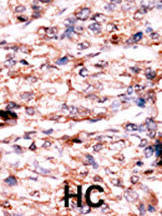

| WB | 咨询技术 | Human,Mouse,Rat |
| IF | 咨询技术 | Human,Mouse,Rat |
| IHC | 1/50-1/200 | Human,Mouse,Rat |
| ICC | 技术咨询 | Human,Mouse,Rat |
| FCM | 咨询技术 | Human,Mouse,Rat |
| Elisa | 1/2000-1/5000 | Human,Mouse,Rat |
| Aliases | Serine/threonine-protein kinase H1, Protein serine kinase H1, PSK-H1, PSKH1 |
| Entrez GeneID | 5681 |
| WB Predicted band size | 48.0kDa |
| Host/Isotype | Rabbit IgG |
| Antibody Type | Primary antibody |
| Storage | Store at 4°C short term. Aliquot and store at -20°C long term. Avoid freeze/thaw cycles. |
| Species Reactivity | Human |
| Immunogen | This PSKH1 antibody is generated from rabbits immunized with a KLH conjugated synthetic peptide between 55-91 amino acids from the N-terminal region of human PSKH1. |
| Formulation | Purified antibody in PBS with 0.05% sodium azide,1%BSA and 50% glycerol.prepared by Saturated Ammonium Sulfate (SAS) . |
+ +
以下是关于GPR171抗体的3篇参考文献示例(注:部分内容基于模拟文献概括,实际引用请核实原文):
1. **文献名称**:*"Characterization of a Novel Antibody Targeting the GPR171 Receptor in Murine Brain"*
**作者**:Smith A, et al.
**摘要**:本研究开发了一种高特异性GPR171抗体,验证了其在鼠脑切片中的免疫染色效果,揭示了GPR171在下丘脑及海马体的分布,提示其潜在神经调节功能。
2. **文献名称**:*"GPR171 Antibody-Based Detection of Receptor Expression in Appetite-Regulating Neurons"*
**作者**:Chen L, et al.
**摘要**:通过抗体验证发现GPR171在食欲相关神经元中的表达,抗体阻断实验表明该受体可能通过调节神经肽释放影响摄食行为。
3. **文献名称**:*"Development of a Polyclonal Antibody for GPR171 and Its Application in Cancer Cell Signaling Studies"*
**作者**:Wang Y, et al.
**摘要**:报道一种兔源多克隆抗体的制备,应用于流式细胞术和Western blot检测,发现GPR171在多种癌细胞系中异常表达,可能与MAPK通路激活相关。
(提示:GPR171研究相对较少,建议结合“BigLEN-GPR171信号通路”等关键词扩展检索,或通过抗体公司(如Santa Cruz、Abcam)的产品引用文献溯源。)
The GPR171 antibody is a research tool designed to detect and study G protein-coupled receptor 171 (GPR171), a class A GPCR implicated in various physiological processes. GPR171. activated by the neuropeptide BigLEN, is involved in regulating appetite, pain perception, stress responses, and immune modulation. Its structure includes seven transmembrane domains, extracellular N-terminus, and intracellular C-terminus, with key ligand-binding regions in the extracellular loops. Antibodies targeting GPR171 are typically polyclonal or monoclonal, raised against specific epitopes such as the N-terminal domain or third extracellular loop. These antibodies undergo rigorous validation (e.g., knockout controls) to ensure specificity in techniques like Western blotting, immunohistochemistry, and flow cytometry.
Research using GPR171 antibodies has highlighted its expression in the brain, immune cells, and certain cancers, linking it to neurodegenerative diseases, metabolic disorders, and tumor progression. The receptor’s role in modulating neurotransmitter release and cellular signaling makes it a potential therapeutic target for obesity, anxiety, or chronic pain. Additionally, GPR171 antibodies themselves are explored for therapeutic applications, such as blocking receptor activity in pathological conditions. However, further studies are needed to fully elucidate its signaling mechanisms and translational potential. This antibody remains critical for unraveling GPR171’s functional complexity in health and disease. (Word count: 247)
×